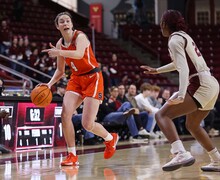Three new programs of study will be available to students in the fall that are designed to provide a more integrated learning experience than the traditional double or dual major.
Integrated Learning Programs in ethics, neuroscience and forensic science will make their debuts at Syracuse University in the coming semester, providing depth in one field, breadth across several others and a capstone to tie two different fields together, according to an April University Senate report on curricula.
“All of the colleges from the university were asked by the chancellor last summer to develop signature programs, and these new integrated program majors are Arts and Sciences’ signature programs,” said Susan Wadley, associate dean of curriculum in the College of Arts and Sciences. “It gives them a broader skill set. We think it will make them very marketable, whether it’s a future school or getting a job in journalism or whatever it might be.”
The new majors give students a more comprehensive and cohesive learning experience, something that double majors, dual majors and various combinations of majors and minors had a hard time doing, according to the USen report.
In double and dual majors, “students gain knowledge of two independent areas, but they invariably lack the connective knowledge to make both work,” according to the USen report. “This problem is further exacerbated by the fact that some broad-based interdisciplinary areas are not available at SU as ‘stand-alone’ majors or minors.”
The new program combines two different majors in a T-shaped structure. The leg of the “T” is a traditional major, such as biology, that students will study in depth. The cross of the “T” is another program of study that does not currently exist but will be created by a combination of other courses. The crossed major has to be interdisciplinary and must be able to relate with several underlying majors, according to the USen report.
A capstone seminar then ties the two sections together. For example, students pursuing the integrated major in neuroscience would take classes from various Arts and Sciences majors, such as biology, physics and psychology, as well as from majors in engineering and computer sciences. The capstone would look at how neuroscience deals with problems beyond the laboratory, according to the USen report.
James Spencer, Arts and Sciences associate dean and chemistry professor, created the idea for the programs. It’s modeled off of the real world, Spencer said, in which employers are looking for workers displaying this same T-shaped structure in their skill set.
“There’s a world outside that’s looking for people who are integrated, who can talk to people outside of their own little discipline,” Spencer said. “So this is an attempt to try to get people more experienced.”
Though they have not found any duplicates yet, Spencer and Wadley did not rule out the possibility that a similar structure in a program of study exists elsewhere.
The program may not be for everyone, Spencer said, but whether students use the new model depends on what they want to do for their career.
“If your goal is that you want to be a laboratory bench chemist and that’s all you want to be, maybe you simply need a B.S. in chemistry,” Spencer said. “But if you’re going to think about questions more broadly or put in a work environment where you need to work in an interdisciplinary team, this might be a good heads-up experience early on.”
The programs in neuroscience, ethics and forensic science each require 24 to 26 credits and can be combined with other majors to complete the “T.”
Arts and Sciences did not have any trouble convincing faculty to get onboard with the idea, Wadley and Spencer said.
SU has plans to expand from three integrated majors to six in the near future. The programs will remain permanent if all goes well, Spencer said.
“I’m a scientist,” Spencer said. “It’s like any experiment. We don’t know the outcome until we run the experiment, so that’s what we’re doing.”
Published on May 3, 2010 at 12:00 pm
Contact Lorne: lefulton@syr.edu





